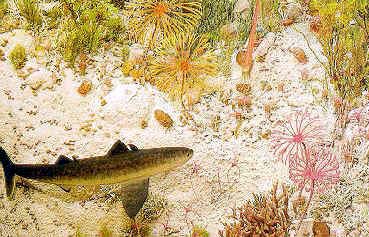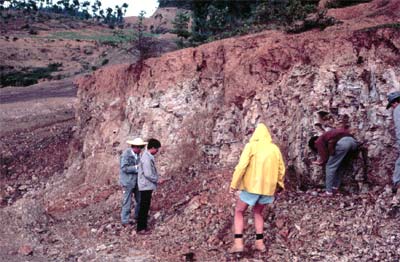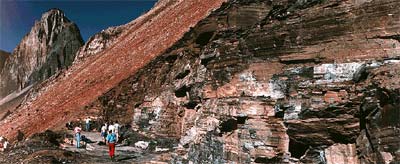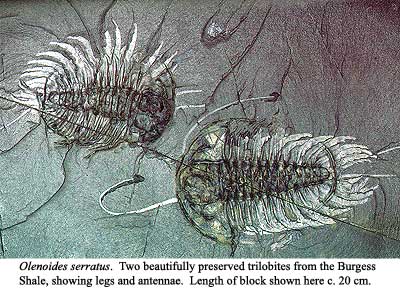| Palaeos: |  |
Paleozoic |
| Paleozoic Era | Paleozoic Era - 1 |
| Page Back | Back: Neoproterozoic | Back: Proterozoic | Up: Phanerozoic | Unit Home |
| Page Next | Next: Mesozoic | Down: Cambrian | Timescale |
| Palaeos: |  |
Paleozoic |
| Paleozoic Era | Paleozoic Era - 1 |
| Page Back | Back: Neoproterozoic | Back: Proterozoic | Up: Phanerozoic | Unit Home |
| Page Next | Next: Mesozoic | Down: Cambrian | Timescale |
The Paleozoic (also spelt "Palaeozoic") era lasted from about 540 to 250 million years ago, and is divided into six periods The 320-odd million years of the Paleozoic era saw many important events, including the development of most invertebrate groups, life's conquest of land, the evolution of fish, reptiles, insects, and vascular plants, the formation of the supercontinent of Pangea, and no less than two distinct ice ages. The earth rotated faster than it does today so days were shorter, and the nearer moon meant stronger tides.
MAK
 Since
the continental cratons all move with respect to each other, we need to pick an
East-West point of reference to keep things straight. Paleozoic
paleocartographers have somehow fallen into the habit of placing this reference
longitude slightly east of Greenland. For most of the Paleozoic, Greenland
remained close to the equator and, after Baltica sutured to Laurentia
(North America plus Greenland) during the Silurian,
this longitude came to correspond quite closely to the longitude of the future
Greenwich, England, which defines the present conventional 0° longitude
line. We will adopt this convention, although it is important to
understand that it's just a convention. We have no absolute measures of
East-West continental drift, and must be content with noting movements relative
to some arbitrary geographical point.
Since
the continental cratons all move with respect to each other, we need to pick an
East-West point of reference to keep things straight. Paleozoic
paleocartographers have somehow fallen into the habit of placing this reference
longitude slightly east of Greenland. For most of the Paleozoic, Greenland
remained close to the equator and, after Baltica sutured to Laurentia
(North America plus Greenland) during the Silurian,
this longitude came to correspond quite closely to the longitude of the future
Greenwich, England, which defines the present conventional 0° longitude
line. We will adopt this convention, although it is important to
understand that it's just a convention. We have no absolute measures of
East-West continental drift, and must be content with noting movements relative
to some arbitrary geographical point.
The early Paleozoic saw many of the continents clustered around the equator, with Gondwana (representing the bulk of old Rodinia) slowly drifting south across the South poles, and Siberia, Laurentia (North America plus Greenland) and Baltica converging in the tropics. There was a large ocean between Laurentia and Eastern Gondwanaland.
It seems that Gondwanaland underwent a large clockwise rotation around an axis close to Australia during the Early Paleozoic. Laurentia underwent a large eastward movement, as well as a northward drift.
Baltica joined with Laurentia during the Silurian, drifting from a moderate southern hemisphere position in Cambro-Ordovician time to an equatorial position in Silurian-Devonian time. The combined continent is sometimes referred to as Euramerica, Laurasia, or Laurussia. Siberia, and possibly the Kazakhstan terranes, drifted across the equator to the northeast. All the East and Southeast Asian terranes, as well as the microcontinents which later formed Mexico, the east coast of North America, and southern Europe, were still part of the north coast (India-Australia margin) of Gondwana during the Early Palaeozoic.
During the middle and late Paleozoic (Devonian to Permian), about a third of the Gondwanan mass was torn into small pieces and moved rapidly to equatorial regions. Most of these blocks were assembled by a series of plate collisions into the supercontinent of Euramerica by the Devonian, which by addition of further landmasses became Laurasia by the late Carboniferous. Most of western Gondwana (South America and Africa), then rotated clockwise and moved northward to collide with Laurasia. By Permian time, Siberia and the Kazakhstan terranes were sutured to Euramerica (Laurussia) and the Chinese blocks started accreting to them. The result was the supercontinent Pangaea. MAK, revised ATW050810.
| eon | era | period | when began
myrs ago ICS |
duration
myrs ICS |
| Phanerozoic | Mesozoic | Triassic | 251 | 51 |
| Paleozoic | Permian | 299 | 48 | |
| Carboniferous | 359 | 60 | ||
| Devonian | 416 | 57 | ||
| Silurian | 444 | 28 | ||
| Ordovician | 488 | 44 | ||
| Cambrian | 542 | 54 | ||
| Proterozoic | Neoproterozoic | Ediacaran ("Vendian") | 630 | 88 |
MAK
 The
Cambrian climate was probably
moderate at first, becoming warmer over the course of the period, as the
second-greatest sustained sea level rise in the Phanerozoic got under way.
However, as if to offset this trend, Gondwana moved south with considerable
speed, so that, in Ordovician time, Most
of West Gondwana (Africa and South America) lay directly over the South
Pole. The Early Paleozoic climate was also strongly zonal, with the result
that the "climate", in an abstract sense became warmer, but the living
space of most organisms of the time -- the continental shelf marine environment
-- became steadily colder. However, Baltica (Northern Europe and Russia)
and Laurentia (eastern North America and Greenland) remained in the tropical
zone, while China and Australia lay in waters which were at least
temperate. The Early Paleozoic ended, rather abruptly, with the short, but
apparently severe, Late Ordovician Ice
Age. This cold spell caused the second-greatest mass extinction of
Phanerozoic time.
The
Cambrian climate was probably
moderate at first, becoming warmer over the course of the period, as the
second-greatest sustained sea level rise in the Phanerozoic got under way.
However, as if to offset this trend, Gondwana moved south with considerable
speed, so that, in Ordovician time, Most
of West Gondwana (Africa and South America) lay directly over the South
Pole. The Early Paleozoic climate was also strongly zonal, with the result
that the "climate", in an abstract sense became warmer, but the living
space of most organisms of the time -- the continental shelf marine environment
-- became steadily colder. However, Baltica (Northern Europe and Russia)
and Laurentia (eastern North America and Greenland) remained in the tropical
zone, while China and Australia lay in waters which were at least
temperate. The Early Paleozoic ended, rather abruptly, with the short, but
apparently severe, Late Ordovician Ice
Age. This cold spell caused the second-greatest mass extinction of
Phanerozoic time.
The Middle Paleozoic was a time of considerable stability. Sea levels had dropped coincident with the Ice Age, but slowly recovered over the course of the Silurian and Devonian. The slow merger of Baltica and Laurentia, and the northward movement of bits and pieces of Gondwana created numerous new regions of relatively warm, shallow sea floor. As plants took hold on the continental margins, oxygen levels increased and carbon dioxide dropped, although much less dramatically. The north-south temperature gradient also seems to have moderated, or metazoan life simply became hardier, or both. At any event, the far southern continental margins of Antarctica and West Gondwana became increasingly less barren. The Devonian ended with a series of turnover pulses which killed off much of Middle Paleozoic vertebrate life, without noticeably reducing species diversity overall.
The Late Paleozoic was a time which has left us a good many unanswered questions. The Mississippian Epoch began with a spike in atmospheric oxygen, while carbon dioxide plummeted to unheard-of lows. This destabilized the climate and led to one, and perhaps two, ice ages during the Carboniferous. These were far more severe than the brief Late Ordovician Ice; but, this time, the effects on world biota were inconsequential. By the Cisuralian, both oxygen and carbon dioxide had recovered to more normal levels. On the other hand, the assembly of Pangea created huge arid inland areas subject to temperature extremes. The Lopingian is associated with falling sea levels, increased carbon dioxide and general climatic deterioration, culminating in the devastation of the end-Permian extinction.
Image: Devonian sea floor scene from the OTS Heavy Oil Science Center.
ATW041218. Text public domain. No rights reserved.
As one might expect from such a vast interval of time, there are a great many Paleozoic sites to choose from. Rather than attempt the impossible task of describing the scars left by 300 My of geological time, we thought we would briefly summarize the ten Paleozoic sites which, in our judgment, had left the greatest mark on paleontology. That, at least, is what we thought. As it turned out, after going through the agonizing job of paring down the list, we found that we could not get much below twelve or fifteen sites. Rather than make some kind of difficult, rational choice, we have simply hacked off the Permian and about half the Carboniferous, as well as randomly discarding some of the many Devonian sites. So you will not see anything from Isheevo or the Karoo, the red beds of Texas, Mazon Creek, Bear Gulch or even Canowindra. Some of these sites are covered in detail elsewhere on this site (which is, of course, one of the ten indispensible sites of Holocene time). Accordingly, without wasting a single electron or pixel more on vain regrets:
 1)
Chengjiang:
Terreneuvian of South China. This
site is discussed at Chenjiang. The
English spellings are somewhat variable, "Chenjiang" being another
popular variant. The correct spelling seems to be 澄江.
It might be better to referred to as the Maotianshan Shale. This is less
accurate (it is more properly the Qiongzhusi Formation), but seems least likely
to be misspelled by ignorant foreigners, such as ourselves. The Chengjiang
fossils are dated at 525-520 Mya, or perhaps a bit younger, corresponding most
nearly to the Botomian Age in our system [1].
Outcrops of the Qiongzhusi occur in scattered locations south of Kunming in
eastern Yunnan Province, Chengjiang County, near the towns of Chengjiang and
Ercai. Additional sites have now been opened further south. Of all the sites mentioned here,
Chengjiang is geologically the oldest
and historically the youngest. The fossil potential of the region was
discovered by Dr. Hou Xianguang in 1984. Many of the fossils have been
recovered -- and many lost forever -- in connection with phosphate mines in the
area. The incredible soft-tissue preservation of the fossils here seems to
have resulted from rapid burial, complete sediment anoxia, and replacement of
organic remains with pyrite or phosphates -- nothing magical,
except the absolutely unreasonable number of such sites, of varying ages, in
Yunnan Province.
1)
Chengjiang:
Terreneuvian of South China. This
site is discussed at Chenjiang. The
English spellings are somewhat variable, "Chenjiang" being another
popular variant. The correct spelling seems to be 澄江.
It might be better to referred to as the Maotianshan Shale. This is less
accurate (it is more properly the Qiongzhusi Formation), but seems least likely
to be misspelled by ignorant foreigners, such as ourselves. The Chengjiang
fossils are dated at 525-520 Mya, or perhaps a bit younger, corresponding most
nearly to the Botomian Age in our system [1].
Outcrops of the Qiongzhusi occur in scattered locations south of Kunming in
eastern Yunnan Province, Chengjiang County, near the towns of Chengjiang and
Ercai. Additional sites have now been opened further south. Of all the sites mentioned here,
Chengjiang is geologically the oldest
and historically the youngest. The fossil potential of the region was
discovered by Dr. Hou Xianguang in 1984. Many of the fossils have been
recovered -- and many lost forever -- in connection with phosphate mines in the
area. The incredible soft-tissue preservation of the fossils here seems to
have resulted from rapid burial, complete sediment anoxia, and replacement of
organic remains with pyrite or phosphates -- nothing magical,
except the absolutely unreasonable number of such sites, of varying ages, in
Yunnan Province.
The faunal list from Chengjiang is a virtually complete census of the major metazoan taxa of the time, and includes our personal favorite of all early chordates, Haikouella. There seems to be little selectivity. There are now Chengjinag fossil images all over the web. However, many of the Chengjiang organisms remain undescribed, simply for lack of competent describers, and new specimens are being discovered at an extraordinary rate.
 2)
The
Burgess Shale: Middle Cambrian of
Canada. The Burgess Shale is slightly younger than Chengjiang.
The Shale is located near the town of Field, in southeastern British Columbia,
high in the Canadian Rockies. The closest major town is Banff, about 90 km
to the east. The site was discovered by Charles Walcott of the Smithsonian
Institution in 1909, and the Walcott Quarry is named after him. The
deposits are deepwater, benthic sediments, but the fauna probably represent a
reef community swept off the reef and buried in an anoxic bottom by a
mudslide. The Burgess is actually far less spectacular than Chengjiang,
but it attained great fame (ironically, just at the time that Chengjiang was
starting to produce large quantities of fossils) due in part to Jay Gould's
book, Wonderful Life.
2)
The
Burgess Shale: Middle Cambrian of
Canada. The Burgess Shale is slightly younger than Chengjiang.
The Shale is located near the town of Field, in southeastern British Columbia,
high in the Canadian Rockies. The closest major town is Banff, about 90 km
to the east. The site was discovered by Charles Walcott of the Smithsonian
Institution in 1909, and the Walcott Quarry is named after him. The
deposits are deepwater, benthic sediments, but the fauna probably represent a
reef community swept off the reef and buried in an anoxic bottom by a
mudslide. The Burgess is actually far less spectacular than Chengjiang,
but it attained great fame (ironically, just at the time that Chengjiang was
starting to produce large quantities of fossils) due in part to Jay Gould's
book, Wonderful Life.
The Burgess Shale's influence on paleontology has been, in part, due to the
fact that Gould chose this book to set out some of his  most interesting and
controversial ideas about evolution, and in a manner readable by almost
everyone. Gould argued that the end results of evolution were
essentially random because the process was chaotic [2].
Thus even the tiniest change in Proterozoic conditions might have resulted in an
entirely different modern fauna. His proof was the diversity of phyla in
the Shale, hinting at an enormous initial diversity in the Cambrian
Explosion which was quickly pruned away, largely by happenstance. As
it has turned out, Gould was certainly wrong about the Burgess Shale.
Chengjiang -- and closer examination of the Burgess fauna -- have shown that
Walcott was more correct than Gould. The great majority of Burgess animals
can now be assigned with confidence to well-known phyla. However, his
ideas about evolution may well be correct, if the pruning process actually
occurred in the lower Early Cambrian or even before metazoans became
morphologically recognizable.
most interesting and
controversial ideas about evolution, and in a manner readable by almost
everyone. Gould argued that the end results of evolution were
essentially random because the process was chaotic [2].
Thus even the tiniest change in Proterozoic conditions might have resulted in an
entirely different modern fauna. His proof was the diversity of phyla in
the Shale, hinting at an enormous initial diversity in the Cambrian
Explosion which was quickly pruned away, largely by happenstance. As
it has turned out, Gould was certainly wrong about the Burgess Shale.
Chengjiang -- and closer examination of the Burgess fauna -- have shown that
Walcott was more correct than Gould. The great majority of Burgess animals
can now be assigned with confidence to well-known phyla. However, his
ideas about evolution may well be correct, if the pruning process actually
occurred in the lower Early Cambrian or even before metazoans became
morphologically recognizable.
| Page Back | Unit Home | Page Top | Page Next |